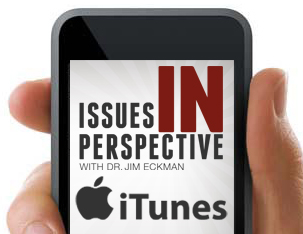Pornography And The Law—The Texas Decision
Aug 23rd, 2025 | By Dr. Jim Eckman | Category: Featured Issues, Politics & Current EventsThe mission of Issues in Perspective is to provide thoughtful, historical and biblically-centered perspectives on current ethical and cultural issues.

On the last day of its term, in the case of Free Speech Coalition v. Paxton, by a 6-to-3 vote the US Supreme Court delivered a decisive ruling against one of the worst industries in America. It upheld a Texas law that requires pornographic websites to “use reasonable age verification methods” to make sure that their customers are at least 18 years old. The court split on ideological lines, with the six Republican appointees voting to uphold the law and the three Democratic appointees in dissent.
A review of the important background of this case: The Free Speech Coalition (a pornography industry trade association) challenged a 2023 Texas law that required sites offering pornographic material to “use reasonable age verification methods” to check whether a user is at least 18. According to the law, “reasonable” methods can include providing “digital identification” to the site or complying with a commercial age verification system. As attorney and columnist David French argues, “At first glance, the law is simple common sense. As Texas noted, all 50 states bar minors from purchasing pornography. Offline, identification requirements are common. Showing a driver’s license to enter a strip club is routine. Zoning restrictions can push pornographic establishments out of neighborhoods and away from schools and other places where kids congregate. Online, though, it is the Wild West. Children have easy access to graphic and hard-core pornography. There’s a certain difficulty in writing about this issue—merely describing what children see online can be too much for adults reading family newspapers to tolerate. As one teenager wrote in The Free Press in 2023, in fourth grade she was exposed to ‘simulated incest, bestiality, and extreme bondage, sex with unconscious women, gangbangs, sadomasochism and unthinkable physical violence.’ Children wouldn’t have a right to see such content even if there wasn’t demonstrable evidence that pornography consumption causes harm. But now that evidence exists.”
David French puts this split decision of the Supreme Court in perspective: “When you see what appears to be a sharp ideological divide on the court, it’s easy to jump to conclusions, to label, for example, the liberals on the court pro-porn compared with the conservatives, but that’s fundamentally wrong. In this case, the most important words from the court came not from Justice Clarence Thomas’s majority opinion but from Justice Elena Kagan’s dissent. ‘No one doubts that the distribution of sexually explicit speech to children, of the sort involved here, can cause great harm,’ Kagan wrote. ‘Or to say the same thing in legal terms, no one doubts that states have a compelling interest in shielding children from speech of that kind. What is more, children have no constitutional right to view it.’ There, in plain English, is a powerful declaration — one that should echo in American law and American culture. From left to right, all nine justices agree that pornography can cause great harm to children. All nine agree not merely that children have no constitutional right to view it but also that the state has a compelling interest in blocking their access. And it’s no wonder. Our nation’s young people are in the midst of a virtual pornography pandemic. The combination of early exposure and the sheer violence and cruelty in so much modern pornography means that children are getting a sex education in exploitation.”
Although a bit complicated, I believe it is worthwhile understanding the legal principles involved in this important decision. Again, David French, an evangelical attorney, helps us decipher the legalese involved:
- Interestingly, the difference between the justices was about not the degree of depravity in porn but rather the precise legal test to use to evaluate the Texas law. The lower court, the Court of Appeals for the Fifth Circuit, had used the most lenient possible standard, rational-basis review. Under rational-basis review, a court will uphold a statute as long as the law has a rational connection to a legitimate state interest. It is exceedingly rare for a court to strike down a law under rational-basis review. Because kids have no right of access to porn, the Fifth Circuit reasoned, the Texas law didn’t implicate the First Amendment, and thus the court should uphold the law so long as Texas could articulate a rational basis for it. Rational-basis review was never going to fly at the Supreme Court. Kids don’t have a right of access to pornography, but adults do, and the identification requirement puts a burden on adults’ rights by requiring them to upload identification (and risk their privacy), which means it couldn’t be the case that only rational-basis review applied.
- But if rational-basis review was wrong, then what was the proper standard? That’s where the court diverged. Justice Clarence Thomas decided to apply a test called intermediate scrutiny, which he described as “deferential but not toothless.” To pass intermediate scrutiny, a law must, according to Cornell Law’s legal encyclopedia, “further an important government interest,” and it “must do so by means that are substantially related to that interest.” In 2019, Thomas wrote, “Pornhub, one of the websites involved in this case, published 1.36 million hours—or over 150 years—of new content.” But the problem extends well beyond the sheer volume of pornography. Citing Nick Kristof’s vitally important 2020 report “The Children of Pornhub,” Thomas explained that “many of these readily accessible videos portray men raping and physically assaulting women—a far cry from the still images that made up the bulk of online pornography in the 1990s.” It is a grotesque industry that produces content like this. An even worse industry makes it available to children.
French makes a crucial point about how the porn industry has evolved: “A generation ago, the Supreme Court struck down efforts to age-limit access to porn websites. The technology was too primitive, and besides, aren’t there other ways to limit kids’ access to pornography? Can’t parents supervise their children? Can’t blocking technology protect young eyes? After more than two decades of effort, the answer is clear: no. Parents can’t protect their kids on their own. Blocking software is laughably inadequate. A 2023 study found that the average age of first exposure to pornography is 12, and 15 percent of teenagers reported first seeing pornography when they were 10 years old or younger. Exposure to pornography at that young an age has a powerful effect on developing minds. A 2017 study, for example, found that early exposure to pornography caused young men to desire power over women. As we know, power is a poor substitute for intimacy and connection.”
French continues: “Easy access is triggering porn addiction on a wide scale. In an amicus brief filed in the case, two scholars who’ve studied the neurological effects of pornography on the human brain argue, ‘The weight of medical evidence demonstrates pornography can become both addictive and compulsive,’ and the effects of addiction ‘are most acute in developing adolescent brains.’ Pornography addiction, they argue, can produce ‘disproportional cue reactivity, a dampening effect on the ability to receive and process pleasure and structural changes to the brain itself.’ Given the vulnerability of the adolescent brain, childhood is ‘the exact worse time for someone to be exposed to pornography.’”
In conclusion, permit me a critical evaluation of the fantasy world pornography creates:
- This fantasy world of pornography is a clear violation of God’s Creation Ordinance (Genesis 2:18-25), which defines the beauty of sex within marriage. Its pleasure and fulfillment are also described in the Song of Solomon. The principles that govern the sexual ethic within marriage are detailed in 1 Corinthians 7:1-7: The principle of mutuality, of mutual duty and of mutual authority. The Bible equally condemns lust as a violation of the sexual ethic laid out by God (e.g., Matthew 5:28; Ephesians 2:3; 1 Thessalonians 4:3-8, etc.). Finally, outside of marriage, abstinence is the only viable option for the believer (see Exodus 20:14; 22:16-17; Proverbs 23:27; 1 Corinthians 5:1; 6:9, 13, 18; Ephesians 5:3, etc.).
- This fantasy world is made possible by the secularization of our culture, by the emphasis on privatization and autonomy, and by the way in which the media depersonalizes and celebrates the seductive nature to sex. Technology, especially the Internet, permits the privatization of sex and autonomy. It is always there and always available.
- A word about masturbation. Almost always, masturbation accompanies pornographic activity (addiction). Scripture never directly addresses the issue, but it is possible to apply clear biblical principles. Where masturbation includes lust or desire for someone other than one’s spouse, Scripture clearly speaks in the negative. If masturbation prevents a spouse from fulfilling one’s duties within marriage, it is wrong. Self-stimulation seems ethically suspect.
- What are the effects of pornography?
- It entices and deceives, never delivering what it promises—intimacy with your spouse.
- It destroys other-centered, agape love within marriage
- It degrades and dehumanizes as it becomes addictive
- It leads to perversion and promiscuity
- It fosters sexual isolation, not intimacy
- It can produce rape, marital violence and abuse
- What is the road back if one is addicted to pornography?
- There must be repentance and absolute, daily dependence on God
- There must be a strategy for holiness (see Ephesians 4:22-24)
- There must be accountability—one-on-one is preferable
For those struggling with pornography, let me recommend, Laurie Hall, An Affair of the Mind and Craig Gross, The Dirty Little Secret: Uncovering the Truth Behind Porn.
See David French in the New York Times (6 July 2025); David French, “Texas Has a Point About Online Pornography” in the New York Times (12 January 2025).


